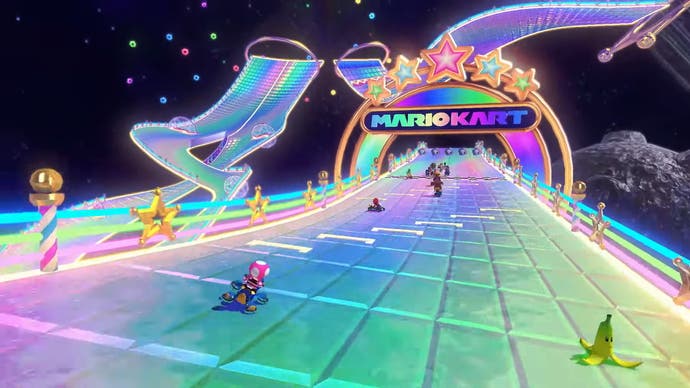Mario Kart’s Blue Shell (officially the Spiny Shell) is one of the most iconic items in video game history. It is also one of the most controversial. A mainstay of the series since Mario Kart 64, the Blue Shell is a laser-guided missile aimed at the first player. It’s almost unavoidable, and completely unavoidable in older games. Every Mario Kart player knows the feeling of fear (and childish injustice) that accompanies the sudden, high-pitched siren whine of the Blue Shell, announcing an unceremonious end to your pleasant lead in the race. But a research project at Queen’s University Belfast has asked a fascinating question about the Blue Shell: does it even work?
Of course, the Blue Shell works in a literal sense: it blows up the hopes and dreams of the first place with depressing accuracy. The question is whether it does what it was designed to do and what people think it does. And if not, why is it such an important part of the game?
The Blue Shell’s prominence may obscure its unusual status in gaming: it’s surprisingly rare for items in competitive multiplayer to specifically target the leader, let alone disable him for several seconds. “Is it not? […] a bit unfair?” Kotaku skeptically asked Hideki Konno, ‘the man behind Mario Kart’, in 2011. One answer would be that it doesn’t have to be fair: ‘unfair’ game mechanics are very important to the way many games function. tough bosses, unpredictable traps, and harsh punishments can help build a world, give a game a sense of risk and difficulty, and determine players’ reaction times.
But that’s not the answer Konno gave. Instead, Konno stated that the Blue Shell was invented to try to increase the competitiveness and fairness of races: “We wanted to create a race where everyone competed until the end.” Several defenses of the Blue Shell are based on the same idea: that the Blue Shell is “obviously” a mechanism for maintaining competitiveness. “Most obviously, it’s the Great Equalizer – the soaring blue embodiment of pure carnage that gives players at the back of the pack a fighting chance,” Nathan Grayson argued in 2014, citing a video from popular YouTuber Extra History: “A reason for the Blue Shell’s existence obviously serves as a catch-up mechanism […] The Blue Shell helps ensure that no one is left completely in the dust without a chance to come back.”
But is that true? Does the Blue Shell help keep races competitive? Alex McMillan, then a computer science master’s student at QUB, wanted to test this piece of gaming wisdom. They came up with a metric called ‘competitive proximity’ to measure how close Mario Kart races are: essentially it’s an averaging of the distance between each successive pair of cars – first and second, second and third, and so on – so it measures how close the race is as a whole, and not just the race between first and second. (After all, beating Pink Yoshi to fifth place in a boring race could be the deciding factor in the tournament, and the Blue Shell is specifically intended to help those at the back.)
Then they tested it out. 50 test participants completed three races each in Mario Kart 64, all at Luigi’s Raceway (to prevent environmental hazards from affecting the results). In one breed there was a regular chance of a Blue Shell; one made you three times more likely than normal to get a Blue Shell, as long as you sat far enough back to qualify; and one removed the Blue Shell completely.
The result? Blue Shells do not significantly affect how close Mario Kart races are. They might be able to make the race leader curse loudly enough to scare the cat, but unlike, say, Golden Mushrooms or Bullet Bills, the player who gets a Blue Shell won’t be meaningfully helped by getting one. So it’s pretty official: the Blue Shell is not a fairness or competitiveness mechanic, and it doesn’t do what it was officially designed to do.
But Mario Kart 7 and 8 director Kosuke Yabuki told Eurogamer in 2017 that when developers have experimented with removing the Blue Shell, they’ve concluded that “there’s something not quite right enough in the game.” So even though the mechanical function of the Blue Shell during a race is surprisingly small, it still serves an important psychological function for players. What could that be?

In their conclusion, McMillan speculates that the Blue Shell is for players whose goal has changed: they are so far off the pace that they no longer expect to win, and can feel disengaged from the race. The Blue Shell gives long-distance players an “illusion of agency”, allowing them to “still feel like they are influencing the race”. The Blue Shell makes the group of players feel the sense of excitement and schadenfreude that accompanies the race leader’s panic, but it also specifically makes the player who threw it feel noticed, impressive, and dangerous. In a game with a lot of pent-up frustration, the Blue Shell allows those left behind to vent their frustration on the race leader, and this can help the group – or even a solo player – release some built-up tension and feel more empowered. positive about playing.
Yabuki himself alludes to this: “One thing I personally really dislike is the human emotional element of the gaming experience,” he says.[and] if you have something that feels unfair or makes you angry… Everyone is different in that regard. What you feel is unfair may be different for someone else.” Yabuki describes wanting to balance the emotions of the experience so that even if a particular player feels frustrated on a particular day, they will still return to Mario Kart next week The Blue Shell can therefore ensure that the frustration is spread across a broader group, instead of focusing it on certain players.
Items that prioritize speed, especially at the expense of other players, are usually most useful in helping back-of-the-pack racers catch up: “Lightning actually does what players want the Blue Shell to do, because it slows down everyone but you,” notes McMillan. So if you really want to compete for victory, prioritize speed items But Mario Kart isn’t just a video game, it’s also primarily a social game, and the accidental genius of the Blue Shell comes from that: the Blue Shell can provide a way for less skilled or less fortunate players to vent without dampening the mood, and can serve as a reminder for the race leaders to pay attention to their friends, too even if it is to give them the middle finger.
So the next time you send someone a Blue Shell, remind them that it’s in the spirit of friendship.
